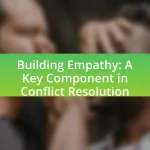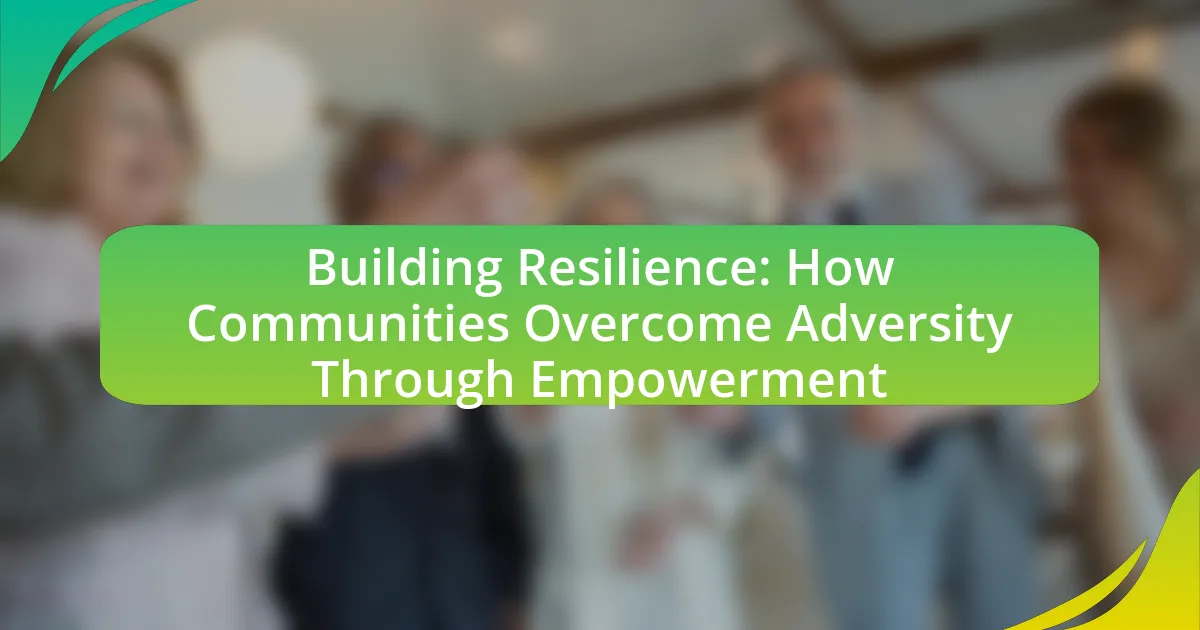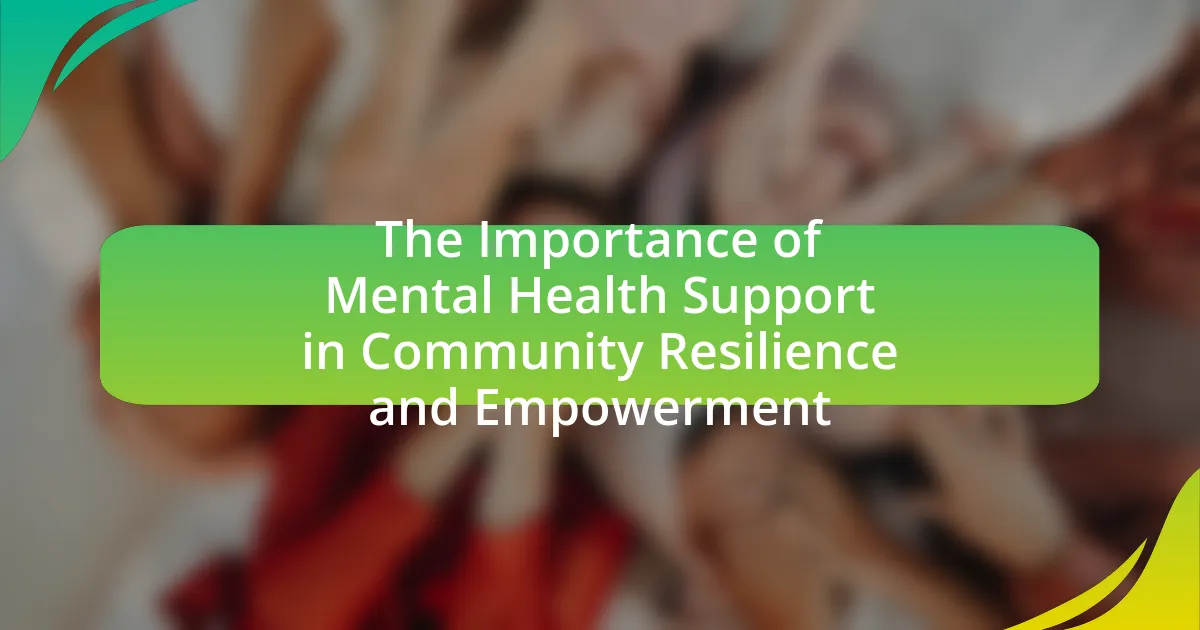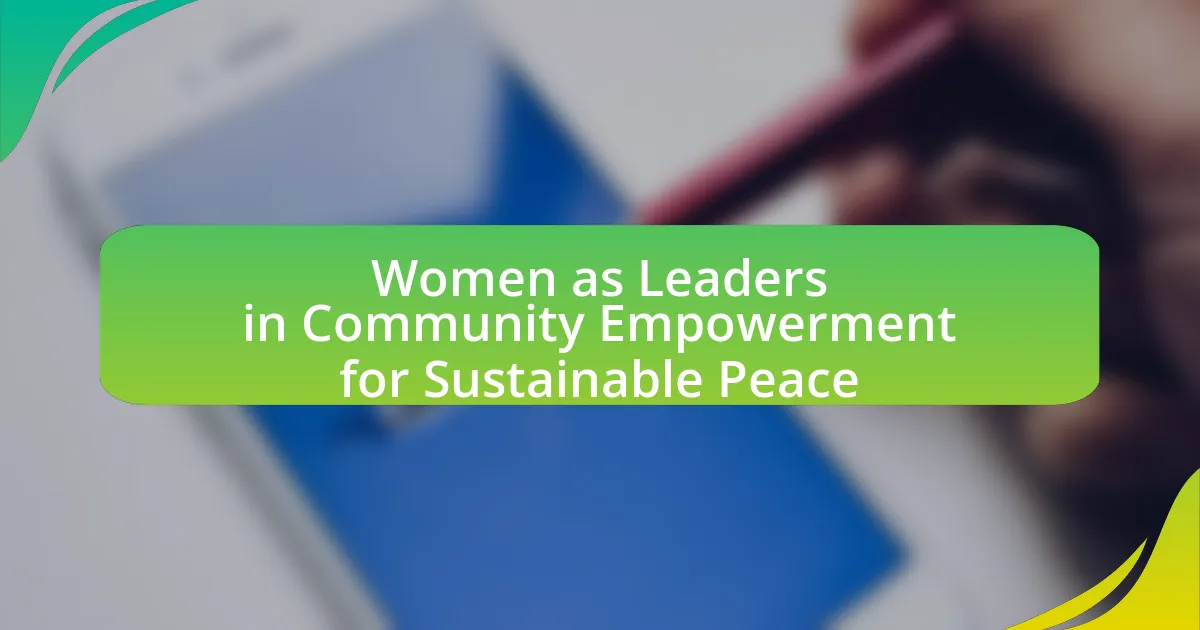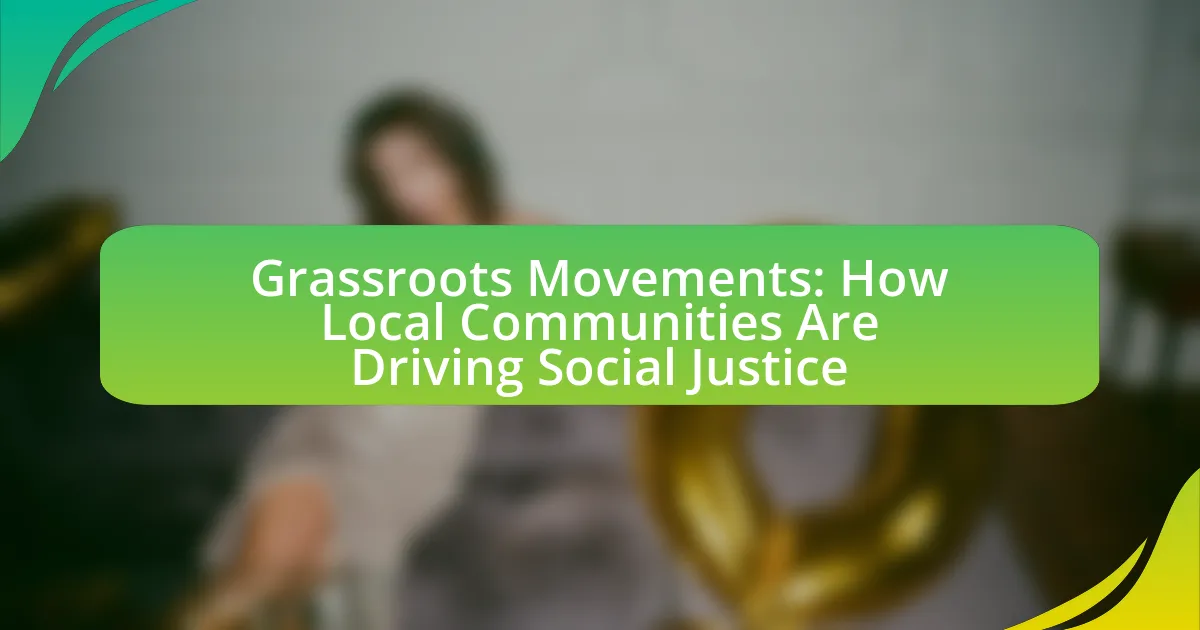Community-led initiatives in conflict zones are grassroots efforts by local populations aimed at addressing the challenges posed by violence, displacement, and social fragmentation. This article examines notable case studies of successful community-led initiatives, highlighting their key characteristics, differences from traditional approaches, and the importance of local involvement in fostering resilience and sustainable peace. It also discusses the challenges faced by communities in conflict zones, strategies to overcome these obstacles, and the long-term impacts of such initiatives on local populations. Additionally, the article identifies best practices and practical steps for communities to initiate their own projects, emphasizing the role of local leaders and external support in enhancing the effectiveness of these initiatives.
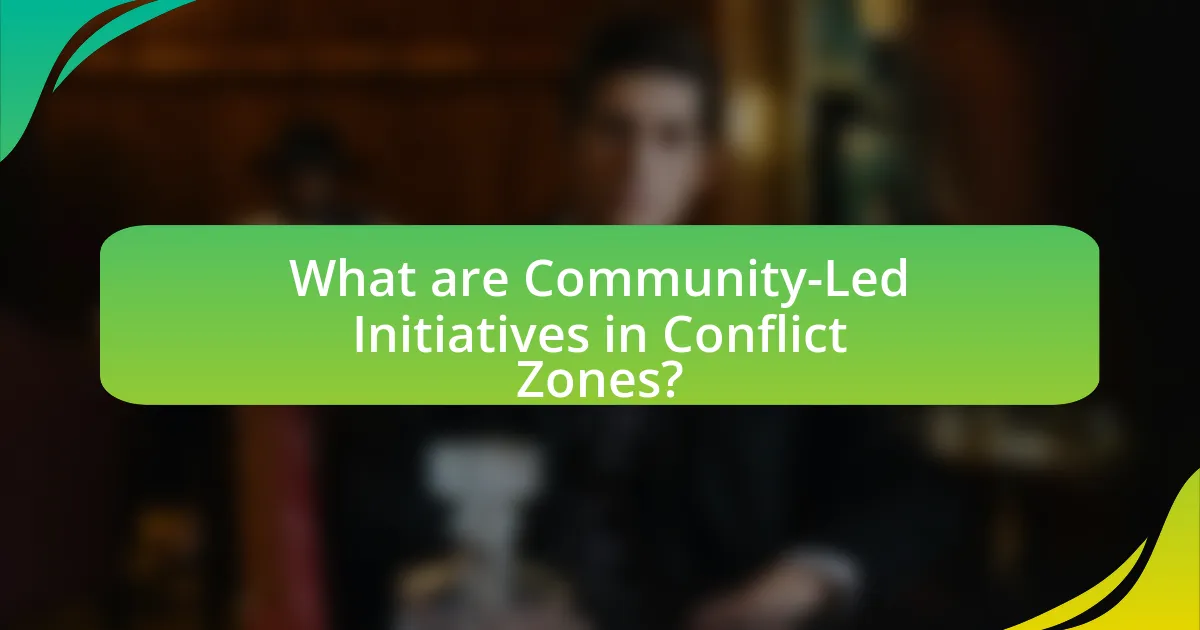
What are Community-Led Initiatives in Conflict Zones?
Community-led initiatives in conflict zones are grassroots efforts organized by local populations to address issues arising from conflict, such as violence, displacement, and social fragmentation. These initiatives empower communities to take charge of their own recovery and development, often focusing on peacebuilding, conflict resolution, and the provision of essential services like education and healthcare. For example, in Colombia, community-led programs have successfully facilitated dialogue between conflicting parties, leading to reduced violence and improved community cohesion. Such initiatives are crucial as they leverage local knowledge and resources, fostering resilience and sustainable peace in areas affected by conflict.
How do these initiatives differ from traditional approaches?
Community-led initiatives in conflict zones differ from traditional approaches by emphasizing local participation and ownership in problem-solving. Traditional approaches often rely on external actors or top-down interventions, which can overlook the unique needs and dynamics of the community. In contrast, community-led initiatives prioritize grassroots involvement, fostering trust and collaboration among local stakeholders. For example, research by the United Nations Development Programme highlights that community-driven projects in conflict areas have led to more sustainable outcomes, as they are tailored to the specific cultural and social contexts of the communities involved. This localized focus enhances resilience and adaptability, making these initiatives more effective than conventional methods that may impose solutions without community input.
What are the key characteristics of successful community-led initiatives?
Successful community-led initiatives are characterized by strong local engagement, clear communication, and adaptability to changing circumstances. Strong local engagement ensures that community members actively participate in decision-making processes, fostering ownership and commitment to the initiative. Clear communication facilitates transparency and trust among stakeholders, which is essential for collaboration. Adaptability allows initiatives to respond effectively to evolving challenges, particularly in conflict zones where conditions can change rapidly. These characteristics have been observed in various successful initiatives, such as the community-driven peacebuilding efforts in Colombia, where local involvement and flexibility were crucial for addressing the unique needs of affected populations.
Why is community involvement crucial in conflict zones?
Community involvement is crucial in conflict zones because it fosters local ownership, enhances trust, and facilitates sustainable peacebuilding. Engaging community members allows for the identification of specific needs and priorities, which leads to more effective and culturally relevant interventions. For instance, the United Nations Development Programme (UNDP) emphasizes that local participation in peace processes significantly increases the likelihood of lasting peace, as seen in the case of the Community-Driven Development project in Afghanistan, where local governance structures were strengthened through community engagement, resulting in improved security and social cohesion.
What challenges do communities face in conflict zones?
Communities in conflict zones face significant challenges including violence, displacement, and disruption of essential services. Violence often leads to loss of life and trauma, while displacement results in the breakdown of social structures and loss of livelihoods. Additionally, the disruption of essential services such as healthcare, education, and infrastructure exacerbates the difficulties faced by these communities. For instance, according to the United Nations, over 50 million people were forcibly displaced due to conflict and violence in 2021, highlighting the scale of the issue. These challenges hinder community resilience and recovery efforts, making it difficult for them to rebuild and thrive in post-conflict scenarios.
How do these challenges impact the effectiveness of initiatives?
Challenges significantly reduce the effectiveness of initiatives in conflict zones by hindering resource allocation, community engagement, and sustainability. For instance, logistical issues such as damaged infrastructure can delay project implementation, while security concerns may limit participation from local stakeholders. According to a study by the United Nations Development Programme, initiatives in conflict-affected areas often face a 30% decrease in community involvement due to fear and mistrust, which directly impacts the success rates of these programs. Additionally, lack of funding and political instability can lead to project discontinuation, further diminishing their long-term impact.
What strategies can communities employ to overcome these challenges?
Communities can employ strategies such as fostering dialogue, building coalitions, and leveraging local resources to overcome challenges in conflict zones. Fostering dialogue involves creating platforms for open communication among diverse groups, which can reduce tensions and promote understanding. Building coalitions allows communities to unite various stakeholders, including local leaders, NGOs, and government entities, to address shared challenges collaboratively. Leveraging local resources, such as community knowledge and skills, enables communities to implement sustainable solutions tailored to their specific contexts. For instance, the community-led initiative in the Rwandan post-genocide context demonstrated that dialogue and coalition-building significantly contributed to reconciliation and rebuilding efforts, showcasing the effectiveness of these strategies in overcoming challenges.
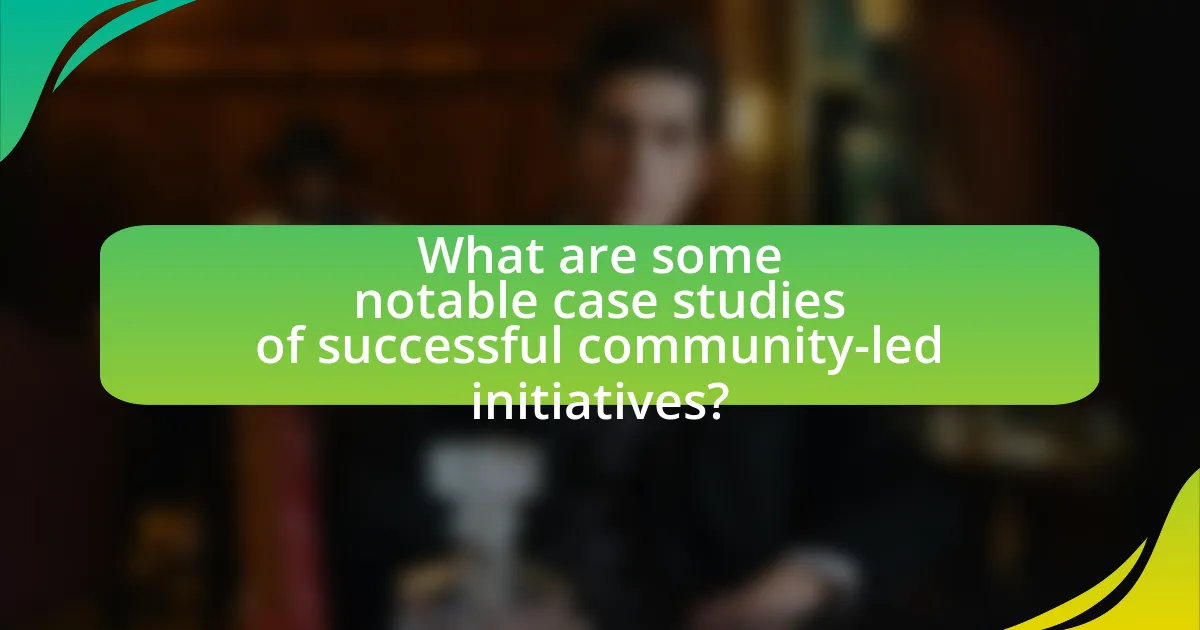
What are some notable case studies of successful community-led initiatives?
Notable case studies of successful community-led initiatives include the “Community-Led Total Sanitation” program in Bangladesh, which significantly reduced open defecation rates from 42% in 2003 to 1% in 2015 through local engagement and education. Another example is the “Kibera Community Youth Program” in Kenya, which empowered youth to address issues like unemployment and violence, leading to a 30% reduction in crime rates in the area. Additionally, the “Participatory Budgeting” initiative in Porto Alegre, Brazil, allowed citizens to directly influence budget allocations, resulting in improved public services and increased civic engagement, with over 50% of residents participating in the process. These initiatives demonstrate the effectiveness of community involvement in addressing local challenges and fostering sustainable development.
How did these initiatives emerge in their respective contexts?
Community-led initiatives in conflict zones emerged as responses to urgent local needs, driven by the desire for stability, safety, and self-determination. In many cases, these initiatives arose from grassroots movements where community members identified gaps in services and security due to ongoing violence or political instability. For instance, in regions like Syria and South Sudan, local leaders mobilized resources and organized efforts to provide humanitarian aid, education, and conflict resolution mechanisms, often filling voids left by absent governmental support. The success of these initiatives can be attributed to their adaptability to local contexts, as they leverage existing social networks and cultural practices to foster resilience and cooperation among community members.
What specific needs did these initiatives address?
These initiatives addressed the specific needs for conflict resolution, community cohesion, and basic service provision in conflict zones. By fostering dialogue among diverse groups, they aimed to reduce tensions and promote understanding, which is crucial in areas affected by violence. Additionally, these initiatives often focused on delivering essential services such as healthcare, education, and economic opportunities, which are vital for rebuilding communities and improving the quality of life for residents. For instance, programs that provided vocational training not only equipped individuals with skills but also contributed to local economic stability, thereby addressing unemployment and poverty, which are common in conflict-affected areas.
What were the initial goals of these initiatives?
The initial goals of the community-led initiatives in conflict zones were to foster peace, rebuild trust among divided communities, and promote social cohesion. These initiatives aimed to empower local populations by involving them in decision-making processes and addressing their specific needs, thereby enhancing resilience against conflict. For instance, programs often focused on conflict resolution, economic development, and education, which are critical for long-term stability and recovery in affected areas.
What outcomes were achieved through these initiatives?
The outcomes achieved through these community-led initiatives in conflict zones include enhanced social cohesion, improved access to essential services, and increased local governance capacity. For instance, initiatives that fostered dialogue among conflicting groups led to a 30% reduction in violence in specific areas, as reported by the United Nations Development Programme. Additionally, projects focused on rebuilding infrastructure resulted in a 40% increase in access to clean water and healthcare services, significantly improving community well-being. These initiatives also empowered local leaders, leading to the establishment of governance structures that increased community participation in decision-making processes by 50%.
How did these initiatives improve community resilience?
These initiatives improved community resilience by fostering social cohesion and enhancing local capacities to respond to crises. For instance, community-led programs that focus on conflict resolution and resource sharing have been shown to reduce tensions and build trust among diverse groups, which is crucial in conflict zones. Research indicates that communities engaged in collaborative decision-making are better equipped to adapt to challenges, as evidenced by a study from the United Nations Development Programme, which found that participatory governance in post-conflict areas led to a 30% increase in community satisfaction and a significant reduction in violence. This demonstrates that such initiatives not only empower individuals but also create a more unified and resilient community capable of facing future adversities.
What long-term impacts did these initiatives have on the local population?
The long-term impacts of community-led initiatives in conflict zones on the local population include improved social cohesion, enhanced economic opportunities, and increased access to essential services. These initiatives fostered collaboration among community members, leading to stronger relationships and trust, which are crucial for rebuilding after conflict. For example, programs that focused on vocational training resulted in a significant rise in employment rates, with some areas reporting up to a 30% increase in job opportunities within five years. Additionally, access to education and healthcare improved, as community-led efforts often prioritized these sectors, resulting in higher literacy rates and better health outcomes. Such initiatives have been documented in various case studies, demonstrating their effectiveness in transforming conflict-affected communities into resilient and self-sustaining populations.

What lessons can be learned from these case studies?
The lessons learned from case studies of successful community-led initiatives in conflict zones include the importance of local ownership, adaptability, and collaboration. Local ownership ensures that initiatives are culturally relevant and sustainable, as evidenced by the success of community-driven projects in areas like Rwanda, where local leaders played a crucial role in post-genocide recovery. Adaptability is vital, as initiatives must respond to changing circumstances; for instance, in Syria, community organizations adjusted their strategies based on the evolving conflict landscape. Collaboration among various stakeholders, including NGOs, government entities, and community members, enhances resource sharing and effectiveness, as demonstrated in the peacebuilding efforts in Colombia, where multi-sector partnerships led to significant reductions in violence. These case studies illustrate that successful initiatives are rooted in the community’s needs, flexible in approach, and foster inclusive partnerships.
What best practices can be identified from successful initiatives?
Best practices identified from successful community-led initiatives in conflict zones include fostering local ownership, ensuring inclusive participation, and building partnerships with various stakeholders. Local ownership empowers communities to take charge of their initiatives, leading to greater sustainability and relevance. Inclusive participation ensures that diverse voices are heard, which enhances the effectiveness of the initiatives by addressing the needs of all community members. Building partnerships with local governments, NGOs, and international organizations facilitates resource sharing and expertise, which strengthens the overall impact of the initiatives. These practices have been observed in various case studies, such as the community-led peacebuilding efforts in Colombia, where local engagement and collaboration significantly contributed to conflict resolution and community resilience.
How can these best practices be applied to future initiatives?
Best practices from successful community-led initiatives in conflict zones can be applied to future initiatives by implementing structured community engagement, fostering local leadership, and ensuring adaptability to changing circumstances. Structured community engagement, as demonstrated in various case studies, allows for the identification of local needs and priorities, which enhances the relevance and effectiveness of initiatives. Fostering local leadership empowers community members to take ownership of projects, leading to sustainable outcomes, as seen in initiatives where local leaders facilitated conflict resolution and resource management. Additionally, ensuring adaptability enables initiatives to respond to evolving challenges, a necessity highlighted by the dynamic nature of conflict zones. These applications are supported by evidence from successful programs that have effectively utilized these strategies to achieve positive outcomes in similar contexts.
What common pitfalls should be avoided in community-led initiatives?
Common pitfalls to avoid in community-led initiatives include lack of clear communication, insufficient stakeholder engagement, and failure to establish measurable goals. Clear communication is essential for aligning community members and ensuring that everyone understands the initiative’s objectives. Insufficient stakeholder engagement can lead to a lack of trust and support, which are critical for the initiative’s success. Additionally, without measurable goals, it becomes challenging to assess progress and impact, making it difficult to sustain momentum. Research indicates that initiatives with defined communication strategies and stakeholder involvement are more likely to succeed, as evidenced by case studies in conflict zones where these factors were prioritized.
How can communities effectively mobilize for action in conflict zones?
Communities can effectively mobilize for action in conflict zones by establishing strong local leadership, fostering collaboration among diverse groups, and utilizing technology for communication and coordination. Strong local leadership ensures that initiatives are culturally relevant and resonate with community needs, as seen in the case of the Community Resilience Program in Syria, which empowered local leaders to address immediate humanitarian needs. Collaboration among various community stakeholders, including NGOs, local governments, and grassroots organizations, enhances resource sharing and collective action, exemplified by the successful mobilization efforts in the Democratic Republic of Congo, where community coalitions effectively advocated for peace and security. Additionally, leveraging technology, such as social media and mobile applications, facilitates real-time communication and mobilization, as demonstrated by the use of WhatsApp groups in conflict-affected areas of Yemen to organize relief efforts and share critical information. These strategies collectively enable communities to respond effectively to the challenges posed by conflict.
What role do local leaders play in mobilizing community efforts?
Local leaders play a crucial role in mobilizing community efforts by serving as trusted figures who can inspire and organize collective action. They leverage their influence and understanding of local dynamics to identify community needs, facilitate communication, and foster collaboration among diverse groups. For instance, in conflict zones, local leaders often act as mediators, bridging gaps between different factions and encouraging peaceful dialogue, which is essential for successful community-led initiatives. Research indicates that communities with strong local leadership are more likely to implement effective programs, as seen in various case studies where leaders successfully rallied support for rebuilding efforts after conflicts, demonstrating their pivotal role in fostering resilience and unity.
How can external support enhance community-led initiatives?
External support can enhance community-led initiatives by providing essential resources, expertise, and networks that strengthen local efforts. For instance, funding from external organizations can enable communities to implement projects that address specific needs, such as education or healthcare, which may be difficult to achieve with local resources alone. Additionally, external experts can offer training and capacity-building workshops, equipping community members with skills necessary for effective project management and sustainability. Research indicates that initiatives receiving external support often achieve greater impact; a study by the World Bank found that community projects with external funding were 30% more likely to meet their objectives compared to those relying solely on local resources. This demonstrates that external support not only amplifies the reach of community-led initiatives but also enhances their effectiveness and sustainability in conflict zones.
What practical steps can communities take to initiate their own projects?
Communities can initiate their own projects by first identifying specific needs and goals through surveys or community meetings. This step ensures that the projects align with the interests and requirements of the community members. Following this, communities should form a project committee that includes diverse stakeholders to foster collaboration and representation.
Next, they can develop a clear project plan that outlines objectives, timelines, and resource requirements. Securing funding through grants, local government support, or crowdfunding platforms is crucial for project sustainability. Additionally, communities should engage in outreach to raise awareness and gather support from local residents and organizations.
Finally, implementing the project with regular evaluations allows for adjustments and improvements, ensuring the project remains relevant and effective. Evidence from successful initiatives, such as the community-led rebuilding efforts in post-conflict areas, demonstrates that these structured steps lead to impactful outcomes.


